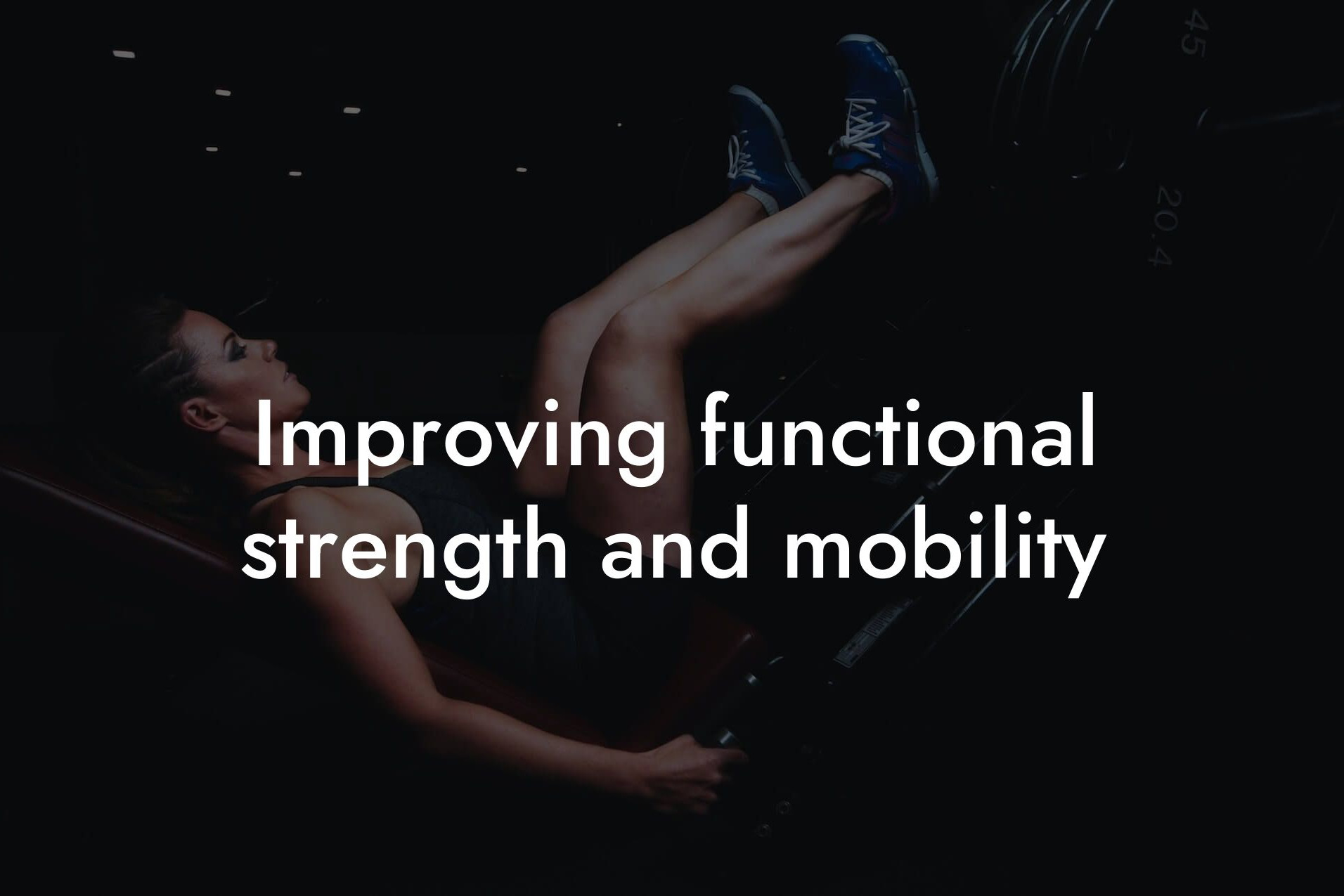As a high-earning professional, you understand the importance of maintaining a healthy and strong physique. Not only does it boost your confidence, but it also enhances your overall well-being and productivity. At Tano Performance Group, we believe that functional exercises are a crucial component of any strength training program. In this article, we'll provide you with expert tips and insights on how to incorporate functional exercises into your workout routine, helping you achieve your fitness goals and take your business to the next level.
Table of Contents
- What are Functional Exercises?
- Benefits of Functional Exercises for High-Earning Professionals
- Key Principles of Functional Exercise Training
- Functional Exercise Examples for High-Earning Professionals
- Creating a Functional Exercise Workout Routine
- Integrating Functional Exercises with DEXA Scanning
- Frequently Asked Questions
What are Functional Exercises?
Functional exercises are a type of strength training that focuses on movements and exercises that mimic real-life activities. They help improve your coordination, balance, and overall functional ability, making it easier to perform daily tasks and activities. Unlike traditional weightlifting exercises that isolate specific muscle groups, functional exercises engage multiple muscle groups simultaneously, providing a more comprehensive workout.
Benefits of Functional Exercises for High-Earning Professionals
As a busy professional, you may not have the time or energy to dedicate to a lengthy workout routine. Functional exercises offer a time-efficient solution, providing a full-body workout in a shorter amount of time. Additionally, functional exercises:
- Improve overall strength and muscle tone
- Enhance flexibility and mobility
- Boost metabolism and burn calories
- Reduce the risk of injury and improve joint stability
- Improve balance and coordination
Key Principles of Functional Exercise Training
When incorporating functional exercises into your workout routine, keep the following principles in mind:
- Focus on multi-planar movements: Functional exercises involve movements that occur in multiple planes of motion, such as sagittal, frontal, and transverse planes.
- Incorporate rotational movements: Rotational movements, such as twisting and turning, are essential for functional exercises.
- Use dynamic movements: Dynamic movements, such as jumping and bounding, are more effective than static movements.
- Engage your core: Your core muscles, including your abs and obliques, play a crucial role in functional exercises.
- Train with intention: Focus on the movement pattern and muscle engagement, rather than just going through the motions.
Functional Exercise Examples for High-Earning Professionals
Here are some examples of functional exercises that you can incorporate into your workout routine:
- Squats: Stand with your feet shoulder-width apart, then bend your knees and lower your body until your thighs are parallel to the ground.
- Lunges: Stand with your feet together, take a large step forward with one foot, and lower your body until your back knee almost touches the ground.
- Step-ups: Stand in front of a step or bench, raise one foot onto the step, and then bring the other foot up to meet it.
- Deadlifts: Stand with your feet shoulder-width apart, bend down and grab a weight or barbell with your hands shoulder-width apart, and lift the weight up to hip level.
- Burpees: Start in a standing position, drop down into a squat position, kick your feet back into a plank position, do a push-up, then quickly return your feet to the squat position and stand up.
Creating a Functional Exercise Workout Routine
When creating a functional exercise workout routine, consider the following:
- Start with 2-3 days per week: Begin with 2-3 days of functional exercise training per week and gradually increase the frequency as your body adapts.
- Incorporate a mix of exercises: Include a mix of upper body, lower body, and core exercises to ensure a comprehensive workout.
- Focus on progressive overload: Gradually increase the weight, resistance, or reps over time to continue challenging your muscles.
- Warm up and cool down: Always warm up with 5-10 minutes of cardio and stretching, and cool down with 5-10 minutes of stretching.
- Listen to your body: Rest and recovery are crucial. If you're feeling fatigued or experiencing pain, take an extra day off or modify the exercise.
Integrating Functional Exercises with DEXA Scanning
At Tano Performance Group, we believe that functional exercises are an essential component of any strength training program. By incorporating functional exercises into your workout routine, you'll be able to optimize your body composition, bone density, and overall physique. Our DEXA scanning technology provides a comprehensive body assessment, giving you a detailed understanding of your body composition and helping you track your progress.
Incorporating functional exercises into your workout routine can have a significant impact on your overall health and fitness. By following the tips and principles outlined in this article, you'll be able to improve your strength, flexibility, and overall functional ability. Remember to start slowly, focus on progressive overload, and listen to your body. With consistency and dedication, you'll be able to achieve your fitness goals and take your business to the next level.
If you're ready to take your fitness journey to the next level, contact us at Tano Performance Group to schedule a DEXA scan and receive a personalized workout plan tailored to your specific needs and goals.
Frequently Asked Questions
What is functional strength training, and how does it differ from traditional weightlifting?
Functional strength training focuses on exercises that improve coordination, balance, and overall functional movement patterns. It differs from traditional weightlifting in that it prioritizes exercises that mimic real-life movements, such as squatting, lunging, and pushing, rather than isolating individual muscle groups. This approach helps improve overall athleticism, reduces the risk of injury, and enhances daily functional abilities.
Why is functional strength training important for high-earning professionals?
High-earning professionals often lead busy lives, and functional strength training can help improve their overall physical fitness, reducing the risk of injury and improving their ability to perform daily tasks with ease. It can also enhance their mental clarity, focus, and productivity, allowing them to tackle their demanding careers with confidence.
What are some examples of functional exercises?
Examples of functional exercises include squats, lunges, deadlifts, push-ups, pull-ups, and rows. These exercises work multiple muscle groups simultaneously, improving overall strength, coordination, and functional movement patterns.
How often should I incorporate functional strength training into my workout routine?
Aim to incorporate functional strength training exercises into your workout routine 2-3 times per week, with at least one day of rest in between. This will allow your muscles to recover and rebuild, ensuring progressive overload and continued improvement.
What is progressive overload, and why is it important in functional strength training?
Progressive overload refers to the gradual increase in weight, resistance, or reps over time to continue challenging your muscles and promoting strength gains. It's essential in functional strength training to ensure continued improvement and to avoid plateaus.
Can functional strength training help with weight loss?
Yes, functional strength training can be an effective way to lose weight and improve body composition. By building muscle mass, you'll increase your resting metabolic rate, helping your body burn more calories at rest. Additionally, functional exercises often engage multiple muscle groups, increasing the caloric expenditure during exercise.
How does functional strength training impact bone density?
Functional strength training can help improve bone density by subjecting your bones to stress and load, stimulating bone growth and density. This is especially important for high-earning professionals, as they may be at risk for osteoporosis or osteopenia due to their sedentary lifestyle.
What are some common mistakes to avoid in functional strength training?
Common mistakes to avoid in functional strength training include poor form and technique, inadequate warm-up and cool-down, and failing to progress exercises over time. It's essential to focus on proper form and technique to avoid injury and ensure effective training.
How can I incorporate functional strength training into my busy schedule?
To incorporate functional strength training into your busy schedule, try to prioritize exercises that can be done in a short amount of time, such as bodyweight exercises or resistance band exercises. You can also try to break up your workout into smaller sessions throughout the day or find a workout buddy to help keep you motivated.
What are some benefits of functional strength training for high-earning professionals?
Benefits of functional strength training for high-earning professionals include improved physical fitness, enhanced mental clarity and focus, increased productivity, and reduced risk of injury. It can also help improve overall confidence and self-esteem, allowing them to tackle their demanding careers with ease.
Can functional strength training be modified for beginners?
Yes, functional strength training can be modified for beginners by reducing the intensity, volume, or complexity of exercises. For example, beginners can start with bodyweight exercises or resistance band exercises and gradually progress to more advanced exercises over time.
How does functional strength training compare to traditional cardio exercises?
Functional strength training can be a more effective and efficient way to improve cardiovascular fitness compared to traditional cardio exercises. This is because functional exercises often engage multiple muscle groups, increasing the caloric expenditure during exercise and improving overall cardiovascular fitness.
Can functional strength training be done at home or does it require a gym membership?
Functional strength training can be done at home with minimal equipment, such as resistance bands or bodyweight exercises. However, having access to a gym can provide a wider range of equipment and exercises to incorporate into your routine.
What are some common injuries associated with functional strength training?
Common injuries associated with functional strength training include muscle strains, tendonitis, and joint injuries. However, these can be minimized by focusing on proper form and technique, warming up and cooling down properly, and incorporating injury prevention exercises into your routine.
How can I track my progress in functional strength training?
To track your progress in functional strength training, try to take progress photos, measurements, or track your workout metrics, such as weight, reps, or sets. You can also work with a personal trainer or fitness coach to help you track your progress and provide feedback.
Can functional strength training be incorporated into a group fitness setting?
Yes, functional strength training can be incorporated into a group fitness setting, such as a boot camp or fitness class. This can provide a fun and motivating environment, as well as accountability and social support.
How does functional strength training impact overall athleticism?
Functional strength training can improve overall athleticism by enhancing power, speed, agility, and coordination. It can also improve reaction time, acceleration, and deceleration, making it an effective way to improve overall athletic performance.
What are some functional strength training exercises for the upper body?
Examples of functional strength training exercises for the upper body include push-ups, pull-ups, rows, and shoulder presses. These exercises can help improve overall upper body strength, power, and endurance.
What are some functional strength training exercises for the lower body?
Examples of functional strength training exercises for the lower body include squats, lunges, deadlifts, and calf raises. These exercises can help improve overall lower body strength, power, and endurance.
How can I incorporate functional strength training into my existing workout routine?
To incorporate functional strength training into your existing workout routine, try to replace traditional exercises with functional exercises, or add functional exercises to the end of your workout as a finisher. You can also try to incorporate functional exercises into your warm-up or cool-down routine.
What are some benefits of functional strength training for overall health and wellness?
Benefits of functional strength training for overall health and wellness include improved physical fitness, enhanced mental health, increased bone density, and reduced risk of chronic diseases, such as heart disease and diabetes.
Here are some related articles you might love...
- Nutrition strategies for functional training enthusiasts
- Improving functional strength and mobility
- The importance of bone density in functional fitness
- Preventing injuries in functional training: A comprehensive guide
- Balancing strength, speed, and flexibility in functional training
- Maintaining muscle recovery with functional training
- How DEXA scans can benefit functional training athletes
- The role of body composition in functional training performance
- Reducing body fat for better functional training results
Zak Faulkner
Zak Faulkner is a leading authority in the realm of physical health and body composition analysis, with over 15 years of experience helping professionals optimise their fitness and well-being. As one the experts behind Tano Performance Group, Zak has dedicated his career to providing in-depth, science-backed insights that empower clients to elevate their physical performance and overall health.
With extensive knowledge of DEXA technology, Zak specializes in delivering comprehensive body assessments that offer precise data on body fat, muscle mass, bone density, and overall physique. His expertise enables individuals to make informed decisions and achieve their fitness goals with accuracy and confidence. Zak’s approach is rooted in a deep understanding of human physiology, combined with a passion for helping clients unlock their full potential through personalised strategies.
Over the years, Zak has earned a reputation for his commitment to excellence, precision, and client-focused service. His guidance is trusted by top professionals who demand the best when it comes to their health. Whether advising on fitness programs, nutritional strategies, or long-term wellness plans, Zak Faulkner’s insights are a valuable resource for anyone serious about taking their health and fitness to the next level.
At Tano Performance Group, Zak continues to lead our Content Team revolutionising how professionals approach their physical health, offering unparalleled expertise that drives real results.




